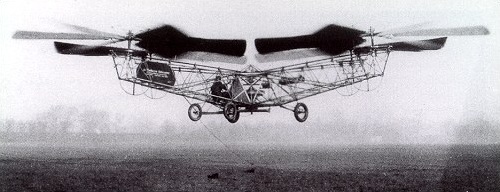<Back to Index>
- Engineer and Inventor Raúl Pateras Pescara de Castelluccio, 1890
- Engineer and Designer Étienne Oehmichen, 1884
- Engineer and Businessman George de Bothezat, 1882
PAGE SPONSOR
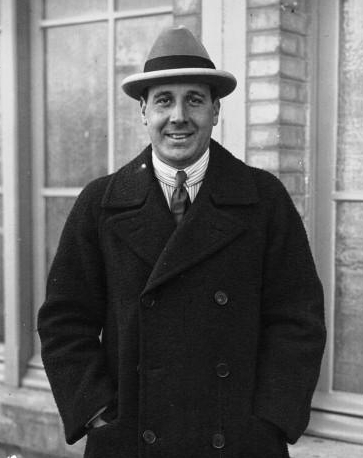
Raúl Pateras Pescara de Castelluccio (born in Buenos Aires in 1890 and died in Paris in 1966), marquis of Pateras - Pescara, was an Argentine engineer and inventor specializing in automobiles, helicopters, as well as free piston engines.
At the beginning of the 20th century, his family returned from Buenos Aires to Europe.
In 1911, Gustave Eiffel workshop tested in their wind tunnel a scale model (1:20) of a monoplane seaplane designed by Pescara and Italian engineer Alessandro Guidoni named the Pateras Pescara. In 1912, the Italian Ministry of the Navy commissioned Guidoni to build a torpedo bomber based on the Pescara model; tests took place in 1914 without success.
From 1919, Pescara built several coaxial helicopters and submitted numerous patents across several countries. He first tested his machine indoor in 1921, before moving to Paris, France, where government funding was available.
His NO. 3 design had two contra - rotating "screws". Each screw being
made up of 4 blades and each blade being a biplane wing with
wing - warping for control.
On January 16, 1924, at Issy - les - Moulineaux near Paris, with his model 2F, "The Marquis Pateras Pescara broke his own world’s records for helicopter flight by remaining in the air eight minutes 13 4/5 seconds while flying 1,160 meters - about two - thirds of a mile – in a vertical line." On January 29 in attempting to win the the French Aero Club prize for a 1 km closed circuit he completed the course in 10 minutes 33 seconds but did not qualify as his machine touched the ground briefly.
Equipped with this type of coaxial double rotor apparatus, he set the first helicopter record recognized by the FAI on April 18, 1924 with a flight distance of 736 m (805 yd), taking 4 minutes 11 seconds - approximately 13 km/h (8.1 mph)) - flying at a height of 1.8 m (5 ft 11 in).
In 1929, with his brother Henri, the Italian engineer Edmond Moglia, and the Spanish government, he founded La Fábrica Nacional de Automóviles ("National Automobile Factory") with an investment of 70 million pesetas. A car, the Nacional Pescara, was exhibited at the 1931 Paris Motor Show, at the Grand Palais, on the stand next to Voisin's. In 1931 this eight cylinder car won the European Grand Prix for hill climbing.
The Spanish Civil War forced Pescara to return to France. On February 28, 1933, the Pescara Auto - compressor Company was unveiled in Luxembourg. It remained in business for 30 years, supported by six French patents. One of its shareholders was the Pescara & Raymond Corporation based in Dover, Delaware, USA. Pescara auto - compressors fall into two basic types: symmetrical and asymmetrical.
During the Second World War, Pescara
worked on electrical power in Portugal. Free piston engines
received new attention when they were mass produced by SIGMA
(Société
industrielle générale de mécanique
appliquée), a French company which developed the GS-34, a 1138
horsepower generator. In 1963, Pescara rejoined his sons in Paris where he served as an expert for S.N. Marep
which was testing its 2000 horsepower EPLH-40. Raúl Pateras -
Pescara
subsequently proposed the production of more powerful machines - new
tandem generators based on the existing EPLH-40 and GS-34. The formation
of a company to apply these processes was underway when Pescara died.
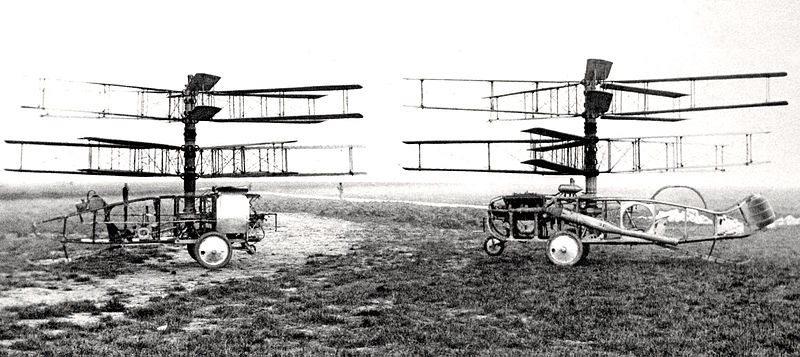
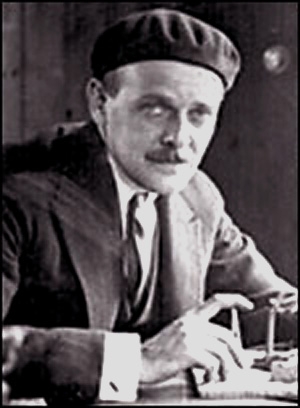
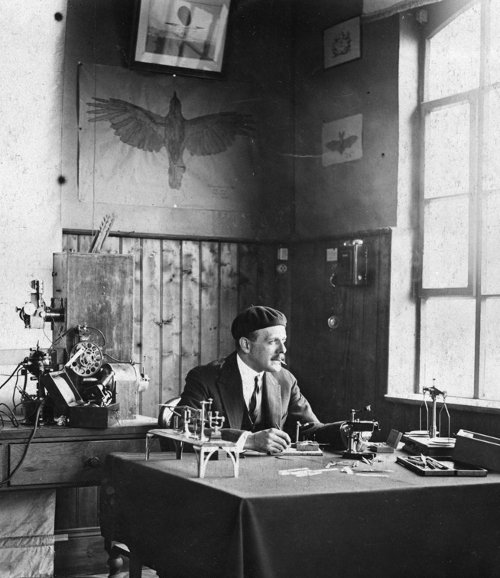
Étienne Oehmichen (* October 15, 1884 in Châlons - sur - Marne Châlons - en - Champagne; † July 10, 1955 in Paris) was a French engineer and helicopter designer.
Oehmichen studied at École Centrale Paris. He patented the first electric stroboscope in 1917, building at the same time a camera capable of shooting 1,000 frames per second.
His first successful flight with a helicopter took place on 18 February, 1921. On 11 November, 1922, he first flew Oehmichen No.2, an improved helicopter featuring small vertically mounted rotors which rotated in the opposite direction from the large lifting rotors, creating probably the first reliable flying helicopter capable of carrying a person. This work later led to the development of the tail rotor. On 14 April 1923, he broke the existing record for helicopter flight with a flight of 358 m. On 4 May 1924 he won a prize of 90,000 French Francs for the first successful closed circuit helicopter flight following a triangular trajectory with a length of approximately one km, a flight which took approximately 7 minutes and 40 seconds. The same year, he even embarked two passengers.
In 1931 Oehmichen invented and tested a type of blimp he called the "Hélicostat", controlled by four movable propellers, which could hover, take off, and land without ground crew.
Oehmichen was also a biologist and dealt with the principle function
of insect wings, especially dragonflies. He worked at the Collège de
France in Paris for 30 years until his retirement.
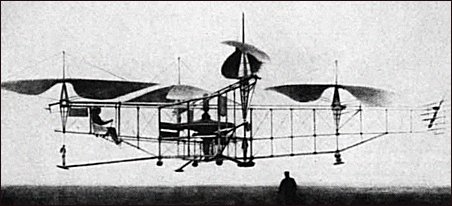
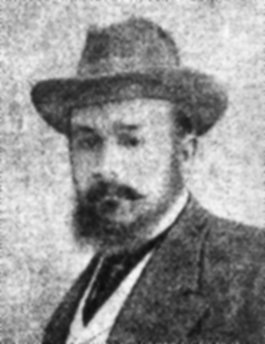
George de Bothezat (Romanian: Gheorghe Botezatu, Георгий Александрович Ботезат, June 7, 1882 – February 1, 1940) was a Russian American engineer, businessman and pioneer of helicopter flight.
George Bothezat was born into a family of Bessarabian landlords in 1882 in Saint Petersburg, Russia. After graduating from a school located in Chisinau in 1902, he attended the Electrotechnical Institute in Belgium between 1905 and 1907, graduated from Kharkiv Polytechnic in 1908, continued his graduate studies in Göttingen and Berlin and received his Ph.D. from the University of Paris for a study of aircraft stability. In 1911, he joined the faculty of Saint Petersburg Polytechnical University and continued theoretical studies of flight along with Stephen Timoshenko, Alexey Lebedev and Alexander Vanderfleet. His scientific interests gradually moved from general aerodynamic theory to applied studies of propellers.
In 1914, Bothezat accepted the position of director at the Polytechnical Institute in Novocherkassk, but the outbreak of World War I compelled him to return to Saint Petersburg and join the Technical Commission of the Imperial Russian Air Force. In 1915, Bothezat published standard bombing tables for the Air Forces, and in 1916 he was appointed chief of the Main Airfield in Saint Petersburg – Russia's first flight research facility. He managed the design team of the DEKA aircraft plant in Saint Petersburg, and was credited with the design of a single engined aircraft that was tested in 1917.
In May 1918, with his homeland in the throes of the Russian Revolution, Bothezat fled from the Bolsheviks to the United States, where he styled himself De
Bothezat. In June 1918, he was hired by the National Advisory Committee
for Aeronautics. He lectured at the Massachusetts Institute of
Technology and the Columbia University.
In 1921 the US Army Air Service hired de Bothezat to build a prototype helicopter. The quadrotor machine, known simply as the de Bothezat helicopter, was built by de Bothezat and Ivan Jerome in the hangars of Wright Field near Dayton, Ohio. The first flight turned out to be surprisingly successful for a machine that had been built without prototyping. In 1922, their "flying octopus" flew many times, although slowly and at low altitudes. In fact, its horizontal motion was induced by wind more than by the pilot's controls. The Army, now more interested in autogyros, cancelled the underperforming project.
De Bothezat returned to New York City and started his own business in making industrial fans, which was incorporated in 1926 as de Bothezat Impeller Company, Inc. The company's axial fans were installed on US Navy cruisers, but this was as far as de Bothezat would go in dealing with the government. He continued publishing essays on topics ranging from flight dynamics to economics of the Great Depression. His 1936 book Back to Newton attacked Albert Einstein's theory of relativity and the whole world of contemporary academics "who are utterly unable to acquaint themselves with the subject". Einstein personally refuted de Bothezat's claim at a public lecture given by de Bothezat at Princeton on 15 June 1935. He worked for the film industry, designing mechanical special effects props for Dudley Murphy's The Love of Sunya (1927).
De Bothezat returned to helicopters in 1938. His new company was incorporated as Air - Screw Research Syndicate and later renamed Helicopter Corporation of America. Boris Sergievsky, former test pilot of Sikorsky Aircraft, became de Bothezat's partner and test pilot. De Bothezat's new helicopter was a coaxial design, with the engine mounted between two rotors. The first machine, SV-2, was built and tested on Roosevelt Field
in 1938; after the tests de Bothezat and Sergievsky rebuilt it into a
heavier SV-5. However de Bothezat, who was also designing a one man "personal helicopter" for infantrymen, died before the SV-5 could be properly tested. The new machine proved to be unstable and crashed; Sergievsky escaped unharmed.
